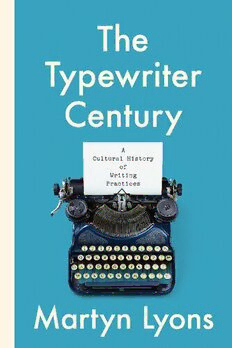
The Typewriter Century: A Cultural History of Writing Practices PDF
Preview The Typewriter Century: A Cultural History of Writing Practices
THE TYPEWRITER CENTURY A Cultural History of Writing Practices The Typewriter Century A Cultural History of Writing Practices MARTYN LYONS UNIVERSITY OF TORONTO PRESS Toronto Buffalo London © University of Toronto Press 2021 Toronto Buffalo London utorontopress.com Printed in the U.S.A. ISBN 978-1-4875-0824-1 (cloth) ISBN 978-1-4875-2573-6 (paper) ISBN 978-1-4875-3783-8 (EPUB) ISBN 978-1-4875-3782-1 (PDF) Studies in Book and Print Culture Library and Archives Canada Cataloguing in Publication Title: The typewriter century : a cultural history of writing practices / Martyn Lyons. Names: Lyons, Martyn, author. Series: Studies in book and print culture. Description: Series statement: Studies in book and print culture | Includes bibliographical references and index. Identifiers: Canadiana (print) 20200304984 | Canadiana (ebook) 20200305018 | ISBN 9781487508241 (hardcover) | ISBN 9781487525736 (softcover) | ISBN 9781487537838 (EPUB) | ISBN 9781487537821 (PDF) Subjects: LCSH: Typewriters – History. | LCSH: Typewriters – Social aspects. | LCSH: Typewriting – History. Classification: LCC Z49.A1 L96 2020 | DDC 652.3 – dc23 Chapter opening illustration: AVA Bitter/Shutterstock.com University of Toronto Press acknowledges the financial assistance to its publishing program of the Canada Council for the Arts and the Ontario Arts Council, an agency of the Government of Ontario. Contents List of Illustrations vii Acknowledgments ix 1 Introduction: The Typewriter as an Agent of Change? 3 2 The Birth of the Typosphere 25 3 Modernity and the “Typewriter Girl” 49 4 The Modernist Typewriter 67 5 The Distancing Effect: The Hand, the Eye, the Voice 86 6 The Romantic Typewriter 105 7 Manuscript and Typescript 121 8 Georges Simenon: The Man in the Glass Cage 137 9 Erle Stanley Gardner: The Fiction Factory 155 10 Domesticating the Typewriter 172 11 The End of the Typewriter Century and Post-Digital Nostalgia 191 Notes 203 Bibliography 239 Index 257 Illustrations 1.1 Len Deighton and his IBM word processor 14 2.1 Malling Hansen’s Writing Ball, c. 1874 29 2.2 Sholes and Glidden typewriter, 1874 34 2.3 The Caligraph typewriter 42 2.4 Dvorak keyboard 46 2.5 Remington advertisement for models 10 and 11, 1909 47 4.1 Guillaume Apollinaire, Salut Monde 75 4.2 Guillaume Apollinaire, Lettre-Océan 77 5.1 Luigi Pirandello dictating to himself 101 6.1 Jack Kerouac, scroll version of On the Road 116 7.1 Richmal Crompton, notes on an envelope 126 10.1 Leo Tolstoy dictating at Yasnaya Polyana 176 10.2 Agatha Christie typing at home, 1952 180 Acknowledgments The idea for this book originated in a museum. On a visit to Sydney’s Powerhouse Museum, which is primarily a museum of technology, I had an unpleasant shock. I spotted a very familiar item displayed in a glass cabinet with an explanatory label for the benefit of the uninitiated. It was a typewriter – a bright red Olivetti portable from the 1960s – and it was familiar because I wrote my own doctoral thesis on the same model. I was confronted by the unsettling reality that an object that had once played an important role in my life had become a museum exhibit, a curious survivor of a now extinct species. It was only later that I came to realize that the real dinosaur was in fact myself. The sight of the Olivetti behind glass was like a vision of myself as historical artefact. My own writing practices have certainly evolved, but slowly. I happily drafted this book and other work before it on a MacBook, but, for some purposes such as writing cheques, I still use a fountain pen, which today is another endangered species. When I used to do this in department stores, it made shop assistants’ jaws drop in amazement. Like Paul Auster with his sturdy German-made Olympia typewriter, “I began to look like an enemy of progress, the last pagan holdout in a world of digital converts.” But the real point of these comments about my existential mini-crisis is that writing technol- ogies like pens and typewriters have a history of their own, and that their history can come to life only if it is told through the eyes of their users. Such a history of writing materials needs to be told if we are to have a more complete appreciation of writing practices in past socie- ties. A chance encounter with an Olivetti in the Powerhouse Museum had given me a new agenda for the cultural history of writing. Having acknowledged both the Powerhouse and my MacBook, I need to say a number of sincere thank yous to some real people. For their contributions in the early stages of preparation of this book, I would
